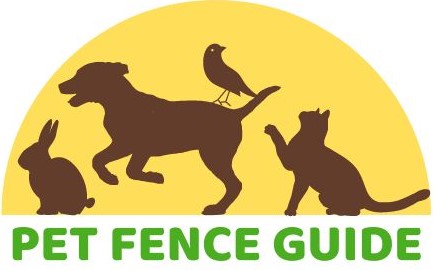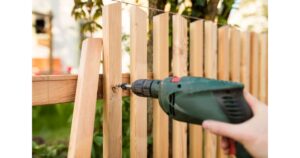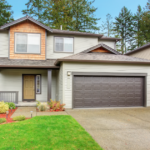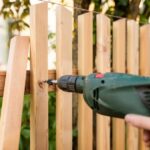
Which Dog Fence Is Best. Types of Dog Fences
Table of Contents
ToggleWhen it comes to choosing a dog fence that balances security, affordability, and utility, the chain-link fence often stands out as a stalwart choice. Over the years, it has gained popularity not only among dog owners but also in various other applications, from commercial and industrial to recreational settings. In this article, we will explore what makes chain-link fences so appealing and why they remain a top choice for many.
How Chain-Link Fences Work
Chain-link fences are constructed using interwoven metal wires that form a mesh pattern. These wires are typically made of steel or aluminum, providing strength and durability. The design allows for an open and transparent barrier, making it easy to see both inside and outside the fence.
The primary purpose of a chain-link fence is to create a physical boundary that restricts access to or from a specific area. They are often used to enclose yards, secure properties, protect construction sites, and define boundaries in various settings.
Advantages of Chain-Link Fences
- Durability: One of the most significant advantages of chain-link fences is their durability. These fences are built to withstand harsh weather conditions, including rain, snow, and strong winds. The metal wires are typically galvanized, making them resistant to rust and corrosion. This durability ensures that your chain-link fence will serve its purpose for many years without the need for frequent repairs or replacements.
- Visibility: Chain-link fences offer excellent visibility, allowing you to see inside and outside the enclosed area. This transparency can be a significant advantage, especially in residential settings, as it maintains a sense of openness and connection with the surroundings. It also prevents the feeling of confinement that solid fences can sometimes create.
- Affordability: Chain-link fences are often more budget-friendly than other fencing options. The materials used are relatively inexpensive compared to wood or vinyl, making them a cost-effective choice, particularly for large areas that need to be enclosed.
Disadvantages of Chain-Link Fences
- Lack of Privacy: While the visibility of chain-link fences can be an advantage, it can also be a disadvantage when privacy is a concern. These fences do not provide privacy, as people and animals outside the fence can easily see through it. If privacy is a priority, you may need to consider other fencing options.
- Not Escape-Proof: While chain-link fences are an effective means of containment for most dogs, some determined or agile dogs may find ways to climb or dig underneath them. To address this issue, additional measures such as a concrete footer or a topper can be added to the fence.
Applications of Chain-Link Fences
Chain-link fences have a wide range of applications due to their durability and affordability. Here are some common uses:
- Residential Fencing: Many homeowners choose chain-link fences to enclose their yards, keeping their pets safe and adding a layer of security.
- Commercial and Industrial Security: Chain-link fences are frequently used to secure commercial and industrial properties, including warehouses, construction sites, and storage facilities.
- Recreation Areas: Parks, playgrounds, and sports facilities often use chain-link fences to define boundaries and enhance safety.
- Pet Enclosures: Dog kennels, animal shelters, and pet boarding facilities rely on chain-link fences to provide secure outdoor spaces for animals.
- Security Fencing: Chain-link fences are an excellent choice for security purposes, whether it’s around a government facility, airport, or private property.
Wooden Fences
How Wooden Fences WorkWooden fences are constructed from wooden panels or boards, creating a solid and visually pleasing barrier. The wood used can vary, with cedar and redwood being popular choices due to their natural resistance to decay and insects. The panels can be arranged vertically or horizontally, and the height can be customized to suit your preferences and needs.
Advantages of Wooden Fences
- Aesthetic Appeal: One of the most significant advantages of wooden fences is their timeless beauty. They add a touch of elegance and charm to any property, enhancing its overall visual appeal. Wooden fences can complement various architectural styles, making them a versatile choice.
- Privacy: Wooden fences excel at providing privacy. With their solid design, they effectively block the view from both inside and outside the enclosed area, allowing you to enjoy your yard without feeling exposed.
- Versatility: Wooden fences offer versatility in terms of design. You can choose from a variety of styles, including picket, board-on-board, lattice, and more. This versatility allows you to customize your fence to match your home’s aesthetic and your taste.
Disadvantages of Wooden Fences
- Maintenance: Wooden fences require regular maintenance to ensure their longevity. This includes painting or staining to protect against weathering and rot. Neglecting maintenance can lead to premature deterioration.
- Cost: While wooden fences provide an array of benefits, they tend to be more expensive upfront compared to some alternatives like chain-link fences. However, many homeowners find the investment well worth it for the aesthetics and privacy they offer.
Applications of Wooden Fences
Wooden fences find application in various settings, including:
- Residential Fencing: Wooden fences are a popular choice for homeowners looking to enhance their property’s curb appeal and create a private and secure backyard space for their families and pets.
- Garden and Landscape Fencing: Wooden fences can be used to enclose garden areas, providing a charming backdrop for landscaping and protecting plants from wildlife.
- Pool Enclosures: Wooden fences are often used to enclose swimming pools, ensuring safety and privacy while adding a touch of elegance to the pool area.
- Boundary Definition: Wooden fences are an excellent way to define property boundaries and establish clear lines of demarcation between neighboring properties.
Vinyl Fences
Vinyl fences have gained popularity as a modern alternative to traditional fencing materials like wood or metal. They offer a unique blend of aesthetics, durability, and minimal maintenance. In this brief overview of vinyl fences, we’ll explore what makes them an appealing choice for homeowners.
How Vinyl Fences Work
Vinyl fences are constructed from synthetic materials, typically polyvinyl chloride (PVC). These materials are molded to create panels or pickets that resemble the appearance of traditional wood or other fencing materials. Vinyl fences come in various styles, from privacy fences with solid panels to ornamental fences with decorative details.
Advantages of Vinyl Fences
- Low Maintenance: One of the most significant advantages of vinyl fences is their minimal maintenance requirements. Unlike wood fences that require regular painting or staining, vinyl fences are virtually maintenance-free. They do not rot, warp, or splinter, and they are resistant to pests and weather damage.
- Durability: Vinyl fences are highly durable and can withstand the elements for many years. They are resistant to moisture, UV rays, and extreme temperatures, ensuring that they remain in excellent condition over time. This durability often comes with a long manufacturer’s warranty.
- Aesthetic Options: Vinyl fences offer a wide range of style options, allowing homeowners to choose a design that matches their preferences and complements their property’s aesthetics. Whether you prefer a classic white picket fence or a contemporary privacy fence, vinyl can emulate the look of wood while retaining its low-maintenance benefits.
Disadvantages of Vinyl Fences
- Initial Cost: While vinyl fences offer long-term cost savings due to their low maintenance, they can have a higher initial installation cost compared to some other fencing materials. However, many homeowners find the investment worthwhile given the long-lasting benefits.
- Not as Eco-Friendly: The production of vinyl materials involves the use of chemicals and may have environmental concerns. Some homeowners may prioritize eco-friendliness and opt for alternative materials.
Applications of Vinyl Fences
Vinyl fences are versatile and can be used in various settings, including:
- Residential Fencing: Vinyl fences are a popular choice for homeowners looking for an attractive and low-maintenance fencing solution to enhance their property’s appearance and security.
- Pool Enclosures: Many pool owners opt for vinyl fences to enclose their pool areas. Vinyl’s resistance to moisture makes it a suitable choice for this application.
- Privacy Fencing: Vinyl privacy fences offer a clean and modern look while providing seclusion in residential properties.
- Commercial and Industrial Use: Vinyl fences are also used in commercial and industrial settings, offering both security and a polished appearance.
Wired Underground Fences
Wired underground fences, often referred to as “invisible fences,” are a modern and innovative solution for dog owners seeking a way to keep their pets safe within specific boundaries without the visual obstruction of traditional fences. .
How Wired Underground Fences Work
Wired underground fences consist of a buried wire that defines a predetermined boundary for your dog. This wire is typically installed a few inches underground and connected to a central transmitter. Your dog wears a specialized collar equipped with a receiver. When your dog approaches the boundary wire, the collar emits a warning tone. If your dog continues to approach the boundary, it receives a mild static correction. Over time, with proper training, most dogs learn to associate the warning tone with the boundary and avoid crossing it.
Advantages of Wired Underground Fences
- Invisibility: The primary advantage of wired underground fences is their discreet nature. Since there are no physical barriers like traditional fences, they do not obstruct your view or interfere with your property’s aesthetics. This allows you to maintain an open and unobstructed yard while still keeping your dog safe.
- Customizable Boundaries: You have control over the shape and size of the containment area, making it adaptable to your yard’s layout. This customization allows you to create boundaries that work for your specific needs.
- Effective Training: Wired underground fences come with a training process that helps your dog understand and respect the boundaries. With consistent training, dogs quickly learn where they can and cannot go.
Disadvantages of Wired Underground Fences
- Installation Complexity: Installing wired underground fences can be labor-intensive and may require some digging. It’s essential to follow the manufacturer’s installation instructions carefully.
- Initial Training Required: Proper training is crucial for your dog to understand and respect invisible boundaries. This training involves teaching your dog to associate the warning tone or static correction with the boundary, which can take time and patience.
- Risk of Escape: While wired underground fences are effective for most dogs, some determined or high-energy breeds may be less responsive to static correction. In such cases, dogs may cross the boundary if sufficiently motivated, such as when chasing prey.
Applications of Wired Underground Fences
Wired underground fences are primarily used for residential purposes and are suitable for:
- Residential Properties: Homeowners looking to keep their dogs within specific boundaries without compromising the aesthetics of their property.
- Yard Protection: Preventing dogs from digging up gardens, damaging landscaping, or accessing restricted areas within the yard.
- Front Yard Safety: Creating a secure front yard boundary to prevent dogs from running into the street or approaching strangers.
Wireless Dog Fences
Wireless dog fences, often known as “invisible fences,” represent a convenient and versatile solution for dog owners who want to give their pets the freedom to roam within defined boundaries while ensuring their safety. This overview will explore how wireless dog fences work and discuss their advantages and disadvantages.
How Wireless Dog Fences Work
Wireless dog fences operate based on a central transmitter that emits a radio signal in a circular pattern. The transmitter is typically placed indoors, and the signal creates an invisible boundary around the yard. Your dog wears a collar equipped with a receiver that detects the signal. When your dog approaches the predetermined boundary, the collar emits a warning tone. If your dog continues to approach the boundary, it receives a mild static correction. Over time and with proper training, most dogs learn to associate the warning tone with the boundary and avoid crossing it.
Advantages of Wireless Dog Fences
- Ease of Installation: One of the most significant advantages of wireless dog fences is their straightforward installation. There is no need for digging or burying wires, making the setup process quick and hassle-free.
- Portability: Wireless dog fences are portable, allowing you to take the system with you if you move or go on vacation. This flexibility is particularly beneficial for those who may change residences.
- Adjustable Boundaries: Many wireless fence systems allow you to customize the size of the containment area to suit your yard’s layout and shape. This adaptability ensures that you can define the boundaries that work best for your needs.
Disadvantages of Wireless Dog Fences
- Signal Interference: The effectiveness of wireless dog fences can be affected by obstacles such as trees, buildings, or uneven terrain. Signal interference can create inconsistencies in the boundary, potentially allowing your dog to cross.
- Limited Boundary Shapes: Wireless dog fences typically work best in circular or oval-shaped boundaries. If you have an irregularly shaped yard, you may encounter limitations in setting up the boundary.
- Training Required: Just like wired underground fences, wireless fences require proper training for your dog to understand and respect the boundaries. Consistent training is essential for success.
Applications of Wireless Dog Fences
Wireless dog fences are primarily used for residential purposes and are suitable for:
- Suburban and Rural Homes: Homeowners with larger properties who want to establish clear boundaries for their dogs without the visual presence of physical fences.
- Vacation Homes: Those who frequently visit vacation homes can use portable wireless fences to create a secure area for their dogs at different locations.
- Temporary Containment: Dog owners who need temporary containment solutions for specific situations, such as construction work in the yard or temporary visitors.
Invisible Dog Fences
Invisible dog fences, also known as underground or electric dog fences, represent a modern and effective solution for pet owners who want to provide their dogs with the freedom to explore while ensuring their safety within predefined boundaries. This overview will delve into how invisible dog fences work and discuss their advantages and disadvantages.
How Invisible Dog Fences Work
Invisible dog fences consist of buried wire that creates an invisible perimeter or boundary within your yard. This wire is typically installed a few inches underground and connected to a central control unit or transmitter. Your dog wears a special collar equipped with a receiver. When your dog approaches the buried wire, the collar emits a warning tone. If your dog continues to move closer to the boundary, it receives a mild static correction, which is designed to deter them from crossing the boundary. With proper training, most dogs quickly learn to associate the warning tone with the boundary and refrain from crossing it.

Advantages of Invisible Dog Fences
- Invisibility: As the name suggests, the primary advantage of invisible dog fences is their discreet nature. There are no physical barriers to obstruct your view or mar the aesthetics of your property. Your yard remains open and unobstructed.
- Customizable Boundaries: Invisible dog fences offer the flexibility to create customized boundaries that match your yard’s layout and shape. This adaptability allows you to define the boundaries that work best for your specific needs.
- Ease of Maintenance: These fences require minimal maintenance compared to traditional fences. There are no physical components to paint, stain, or repair, reducing the time and effort needed to keep your wall in good condition.
Disadvantages of Invisible Dog Fences
- Training Required: Proper training is crucial for your dog to understand and respect invisible boundaries. Consistent training is essential to ensure your dog’s safety and prevent them from crossing the boundary.
- Risk of Escape: While invisible dog fences are effective for most dogs, some particularly determined or high-energy breeds may be less responsive to static correction. In such cases, dogs may cross the boundary if they are motivated enough, such as when chasing prey.
- Initial Installation Complexity: Installing invisible dog fences can be labor-intensive, involving digging to bury the wire. It’s essential to carefully follow the manufacturer’s installation instructions.
Applications of Invisible Dog Fences
Invisible dog fences are primarily used for residential purposes and are suitable for:
- Residential Properties: Homeowners looking to provide their dogs with a secure and open space to roam without the visual presence of traditional fences.
- Yard Protection: Preventing dogs from digging up gardens, damaging landscaping, or accessing restricted areas within the yard.
- Front Yard Safety: Creating a secure front yard boundary to prevent dogs from running into the street or approaching strangers
Which Dog Fence Is Best. Factors to Consider When Choosing a Dog Fence
- Choosing the right dog fence is a crucial decision for pet owners. It’s not just about establishing boundaries; it’s about ensuring the safety, comfort, and well-being of your beloved canine companion. Several factors should be taken into account when selecting the most suitable fence for your specific needs. In this comprehensive guide, we will explore these factors in detail to help you make an informed decision.
A. Dog’s Size and Breed
The first and most critical factor to consider when choosing a dog fence is your dog’s size and breed. Different dogs have different needs and abilities, and the fence you select should match these characteristics:
- Size: Larger dogs may require taller fences to prevent them from jumping over or climbing. Smaller breeds may be more agile and able to squeeze through smaller gaps, so you’ll need to consider the fence’s spacing and design.
- Energy Level: High-energy breeds, such as Border Collies or German Shepherds, may need a fence that provides them with enough space to exercise and burn off their energy. In contrast, calmer breeds may be content with a smaller yard.
- Digging Tendencies: Some dogs have a natural inclination to dig. If you have a digger, you might need to consider reinforcing the fence with a barrier that extends below ground level.
B. Yard Size and Layout
The size and layout of your yard play a significant role in determining the type of fence that will work best for you:
- Yard Shape: Consider the shape of your yard. Is it square, rectangular, irregular, or circular? The shape will impact the design and placement of your fence.
- Yard Size: A smaller yard may not require a vast expanse of fencing, but it’s essential to ensure it provides ample space for your dog to move comfortably. In larger yards, you have more flexibility in choosing the fence’s location and design.
- Obstacles: Take note of any existing obstacles in your yard, such as trees, shrubs, or structures. These can affect the placement and installation of the fence.
C. Budget Considerations
Budget is another crucial factor when selecting a dog fence. The initial cost of the fence, as well as long-term maintenance expenses, should be carefully evaluated:
- Initial Cost: Different types of fences come with varying price tags. Chain-link fences and wired underground fences tend to be more budget-friendly, while wooden or vinyl fences may have a higher upfront cost.
- Maintenance Costs: Consider the ongoing maintenance expenses. Wooden fences, for instance, may require periodic staining or painting, while vinyl and metal fences are low-maintenance options.
- Repairs and Replacements: Factor in the potential costs of repairs or replacements. Over time, all fences may require some maintenance, and it’s essential to be prepared for these expenses.
D. Aesthetic Preferences
The appearance of the fence matters, not just for your dog’s containment but also for enhancing the overall look of your property:
- Style: Different fence materials and designs offer varying aesthetic options. Wooden fences, for example, can provide a classic and rustic charm, while vinyl fences offer a more modern and clean appearance.
- Color and Finish: Consider the color and finish of the fence. Some materials, like vinyl, offer a range of color choices, allowing you to select one that complements your property’s aesthetics.
- Privacy vs. Openness: Determine whether you prioritize privacy or prefer an open and transparent fence. Wooden fences excel at providing privacy, while chain-link fences offer visibility.
E. Local Regulations and Zoning Laws
Before finalizing your fence selection, it’s crucial to ensure that it complies with local regulations and zoning laws:
- Height Restrictions: Many areas have restrictions on fence height. Make sure your chosen fence’s height adheres to local regulations.
- Materials and Design: Some communities have guidelines on the materials and design of fences. Check to see if your selected fence meets these requirements.
- Permit Requirements: In some cases, you may need a permit to install a fence. Verify with your local authorities whether any permits are necessary before installation.
Which Dog Fence Is Best. Making the Final Decision
- A. Weighing the pros and cons of each type of fence
- B. Consulting with a professional if necessary
- C. Considering long-term costs and maintenance
- D. Safety and well-being of your dog as the top priority

Conclusion
In conclusion, choosing the best dog fence is a significant decision for any pet owner. The type of fence you select should align with your dog’s needs, your yard’s layout, and your budget. Whether you opt for a traditional fence, an electric dog fence, or an invisible fence, the ultimate goal is to create a safe and secure environment for your furry friend. By considering all the factors discussed in this article, you can make an informed decision and provide your dog with the protection and freedom they deserve.








